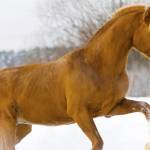Cold Weather Feeding Tips

Paying attention to special nutritional considerations can help a horse overcome the challenges of dealing with cold weather.
- Lots of forage is crucial to keeping a horse warm. Fermentation of fiber in the forage produces significantly more internal heat than digestion of grains or fats. For a horse to get the maximum benefit from the warming calories in forage, feed free-choice hay.
- When the outside temperature dips below the thermoneutral zone of the horse, a horse will burn more calories than normal to keep warm. A horse needs even more calories to keep from losing weight at this time. Provide more forage and grain if the horse cannot maintain weight on forage alone.
- Subcutaneous fat helps to maintain body heat, so a horse is better off going into cold seasons moderately fleshy than thin. In the cold weather, it takes more calories to maintain weight on a thin horse than a moderately fleshy one.
- Young, thin-coated, and aged horses are less cold tolerant than mature horses with normal winter hair coats in optimal body condition. Dietary considerations should be made as temperatures drop to avoid detrimental weight loss. Horses not acclimated to frigid weather need about three weeks to adjust to colder temperatures.
- The more time the horse spends chewing, the more heat produced. Eating hay requires two times as many chews per bite than grain and slows the rate of intake. Further, more chewing produces more saliva, which helps buffer gastric acid and prevent ulcers.
- Textured feeds with molasses become difficult to scoop in the cold, particularly those containing beet pulp. Keep textured feeds in a heated area for ease of handling. Feeds that include beet pulp can be served with warm water added immediately before feeding. Pelleted feeds are much easier to dole out in cold weather.
- Cold weather can reduce water intake by as much as 14%. Adequate water intake is vital to prevention of impaction colic. Drinking cold water can be painful for a horse with bad teeth, so owners of horse with dental problems should keep a close eye on water consumption.
- Horses housed outside drink more if the water is at a moderate temperature (45°-65° F, 7°-18° C) rather than almost freezing. Water heaters or special water fountains will keep water from freezing. Check water regularly for stray voltage caused by faulty electric water heaters or for water that is too hot, as both will deter horses from drinking.
- Encourage water consumption by adding 1-2 oz (28-56 g) of salt to daily feed. Other ways to introduce more water into the horse include feeding soaked beet pulp or warm bran mash.
- Boost the horse’s immune system by feeding additional omega-3 fatty acids and vitamin E. Fish oil and flax/linseed oil are high in omega-3 fatty acids. Fish oil, such as EO-3, is the richest source of certain omega-3 fatty acids. Natural vitamin E (d-alpha tocopherol) is a better source than synthetic (dl-alpha tocopherol). Nano-E is a research-proven natural source of vitamin E that is highly digestible.








